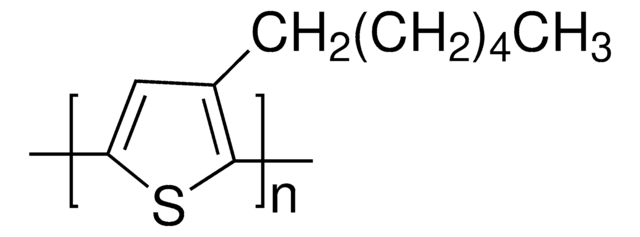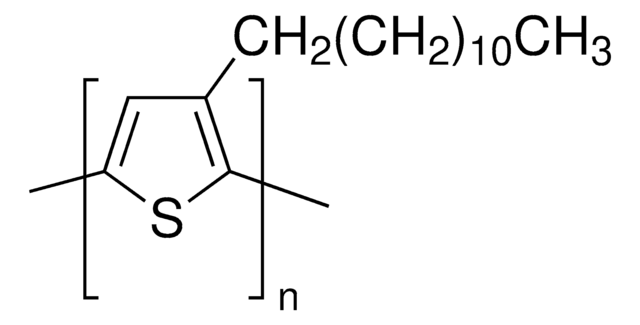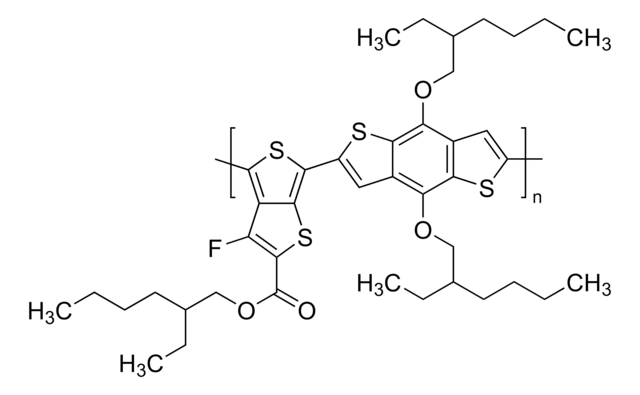Regioregular means all of the monomer units are in the same orientation. E.g. if you think of each monomer unit as your palm, regioregular would have all palms facing away, fingers up - all in same orientation. (Regiorandom might have one pointing up, one pointing down, one with palms facing you, one with palms facing away, etc, all in a row.)
445703
Poly(3-hexylthiophene-2,5-diyl)
regioregular
Synonym(s):
P3HT
Select a Size
About This Item
Recommended Products
Quality Level
mol wt
average Mw 50,000-100,000
greener alternative product characteristics
Design for Energy Efficiency
Learn more about the Principles of Green Chemistry.
sustainability
Greener Alternative Product
conductivity
~103 S/cm (when doped with iodine)
mp
238 °C
238 °C
fluorescence
λex 443 nm; λem 568 nm in chloroform
Orbital energy
HOMO 5 eV
LUMO 3 eV
OPV Device Performance
ITO/NiO/P3HT/PC61BM/LiF/Al
- Short-circuit current density (Jsc): 11.3 mA/cm2
- Open-circuit voltage (Voc): 0.64 V
- Fill Factor (FF): 0.69
- Power Conversion Efficiency (PCE): 5.16 %
ITO/PEDOT:PSS/P3HT:PC61BM (1:08)/Al
- Short-circuit current density (Jsc): 9.5 mA/cm2
- Open-circuit voltage (Voc): 0.63 V
- Fill Factor (FF): 0.68
- Power Conversion Efficiency (PCE): 5 %
greener alternative category
semiconductor properties
P-type (mobility=1E-4-1E-1 cm2/V·s)
Looking for similar products? Visit Product Comparison Guide
General description
Application
Features and Benefits
Good processibility, environmental stability and electroactivity.
Packaging
Legal Information
Rieke is a registered trademark of Rieke Metals, Inc.
Storage Class Code
11 - Combustible Solids
WGK
WGK 3
Flash Point(F)
Not applicable
Flash Point(C)
Not applicable
Personal Protective Equipment
Choose from one of the most recent versions:
Certificates of Analysis (COA)
Don't see the Right Version?
If you require a particular version, you can look up a specific certificate by the Lot or Batch number.
Already Own This Product?
Find documentation for the products that you have recently purchased in the Document Library.
Customers Also Viewed
Articles
Flexible electronic circuits and displays based on organic active materials are future generations of products that may eventually enter mainstream electronics market.
PCBM-based n-type semiconductors - Find p- and n-type organic semiconductors available with PCBM library & properties.
Flexible electronic circuits, displays, and sensors based on organic active materials will enable future generations of electronics products that may eventually enter the mainstream electronics market.
The application of conducting polymers at the interface with biology is an exciting new trend in organic electronics research.
-
For Product 445703, Poly(3-hexylthiophene-2,5-diyl), what does regioregular mean?
1 answer-
Helpful?
-
-
For Product 445703, Poly(3-hexylthiophene-2,5-diyl), what does "diyl" refer to?
1 answer-
The use of "diyl" is simply an extension of the use of the "yl" ending for a single substituent. For example, a monosubstituted ethane becomes ethyl - - - -, a monosubstituted propane becomes propyl - - - -, a monosubstituted butane becomes butyl - - - - and so on. Similarly, a 1,3-disubstituted butane becomes 1,3-butanediyl, indicating the presence of similar substituents on the 1- and 3- positions of the butane portion of the molecule.
Helpful?
-
-
For product 445703, Poly(3-hexylthiophene-2,5-diyl), what are the end groups for the polymer? What is the initiator for the polymerization?
1 answer-
For product 445703, Poly(3-hexylthiophene-2,5-diyl), one end group is a hydrogen and the other end group is a bromine. The name of the initiator for the polymerization is proprietary information.
Helpful?
-
-
What is the Department of Transportation shipping information for this product?
1 answer-
Transportation information can be found in Section 14 of the product's (M)SDS.To access the shipping information for this material, use the link on the product detail page for the product.
Helpful?
-
-
What percentage is regioregular in Product 445703, Poly(3-hexylthiophene-2,5-diyl)?
1 answer-
Based on proton NMR, it is estimated to be approximately 98% regioregular.
Helpful?
-
-
What is the molecular weight of Product 445703, Poly(3-hexylthiophene-2,5-diyl)?
1 answer-
The molecular weight (MW) is approximately 87,000.
Helpful?
-
-
What is Product 445703, Poly(3-hexylthiophene-2,5-diyl), soluble in?
1 answer-
This product will be soluble in Carbon Tetrachloride, Chloroform, and Dichloromethane. It is also partially soluble in Tetrahydrofuran, ether and slightly soluble in Toluene.
Helpful?
-
Active Filters
Our team of scientists has experience in all areas of research including Life Science, Material Science, Chemical Synthesis, Chromatography, Analytical and many others.
Contact Technical Service

![[6,6]-Phenyl C61 butyric acid methyl ester ≥99%](/deepweb/assets/sigmaaldrich/product/structures/359/221/d990c746-0960-4c69-bf76-fe09b193824d/640/d990c746-0960-4c69-bf76-fe09b193824d.png)






